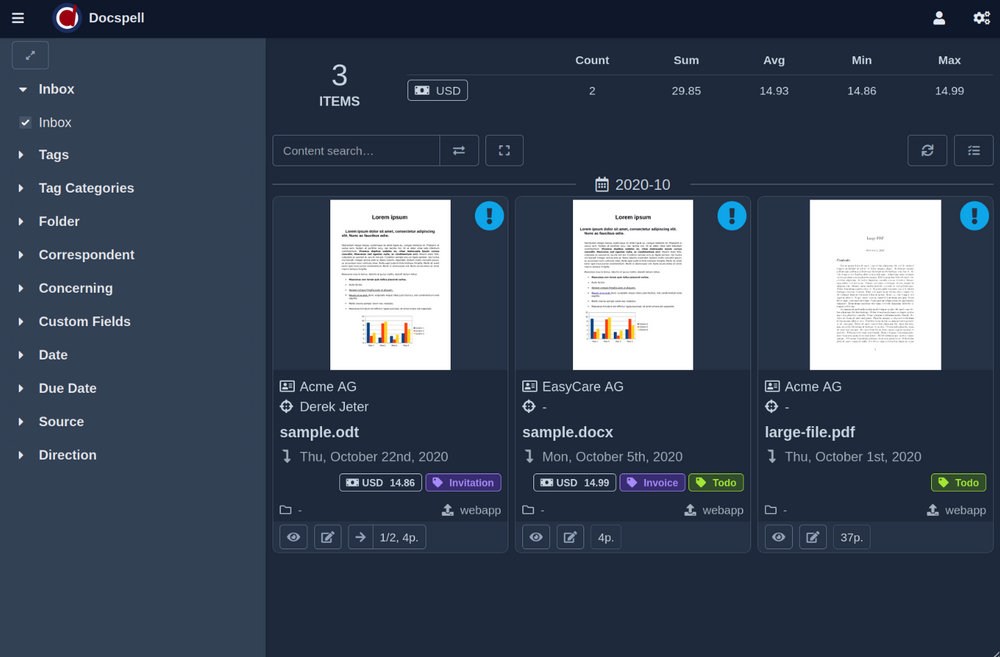
Docspell is a personal document organizer. Or sometimes called a "Document Management System" (DMS). You'll need a scanner to convert your papers into files. Docspell can then assist in organizing the resulting mess .
It can unify your files from scanners, emails and other sources. It is targeted for home use, i.e. families, households and also for smaller groups/companies.
To summarize, Docspell assists you in organizing your piles of documents, resulting from scanners, e-mails and other sources with miminal effort.
You can associate tags, set correspondends and lots of other predefined and custom metadata. If your documents are associated with such meta data, you can quickly find them later using the search feature.
But adding this manually is a tedious task. Docspell can help by suggesting correspondents, guessing tags or finding dates using machine learning. It can learn metadata from existing documents and find things using NLP. This makes adding metadata to your documents a lot easier. For machine learning, it relies on the free (GPL) Stanford Core NLP library.
Docspell also runs OCR (if needed) on your documents, can provide fulltext search and has great e-mail integration. Everything is accessible via a REST/HTTP api. A mobile friendly SPA web application is the default user interface. An Android app exists for conveniently uploading files from your phone/tablet and a cli. The feature overview lists some more points.
Features
- Cross-platform
- Multi-User per Account
- Full-Text Search that search files meta-data, fields, and document content
- It comes with a rich bookmark manager tool
- It offers a rich text analysis tools that is powered by machine learning (ML) algorithms
- Users can add their own tags
- Compare documents easily
- Supports dozens of file format
- Easy convert documents to PDF files
- Drag-and-drop file tool
- Webhooks ready
- Manage your file collections easily
- It has a built-in OCR system
- Comes with a built-in PDF and document viewer
- Set document meta tags
- Share files via emails
- Mobile-ready interface
- User can install in mins using Docker
- User can manage their folders, tags, collections, tag categories, and more
- User can setup custom-fields for files and collections
- Filter docs by date, fields, custom fields, folders, tags, user-tags, concerning, source, type and modified date
- Manage multi-organizations
- Built-in browser notification
Install Docspell
Docspell can be installed easily using Docker and Docker Compose in 5 easy steps
1- Clone the project repo
git clone https://github.com/eikek/docspell2- Change to the docker-compose directory
cd docspell/docker/docker-compose
4- Run the app using Docker-compose
docker-compose up -d5- Head to your newly installed system:
Goto http://localhost:7880, signup and login. When signing up, choose the same name for collective and user. Then login with this name and the password.
Tech Stack
Backend
The servers is written in Scala in a pure functional style, based on libraries from the typelevel stack: Cats, FS2, Doobie, Http4s, Circe and Pureconfig.
There are more libraries and technologies used, of course. Docspell is only a orchestration of great tools and libs. One important is the Stanford-NLP, that provides the ML features. Furthermore, file processing relies on external tools like tesseract, unoconv and ocrmypdf. All dependencies can be looked up in project/Dependencies.scala.
Frontend
The web frontend is a SPA written in Elm. The UI framework in use is tailwind.
License
Docspell is free software, distributed under the AGPLv3 or later.
